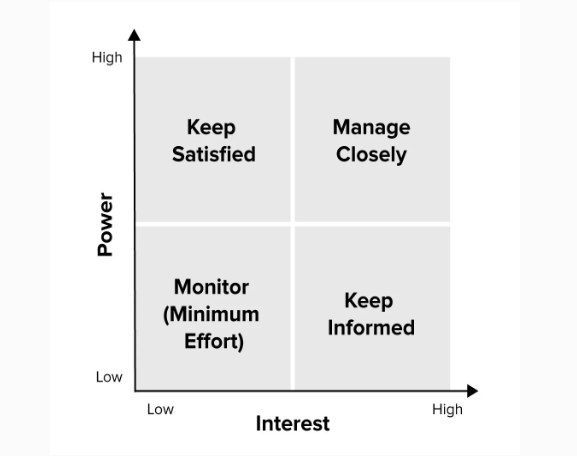Anybody who is affected positively or negatively by doing a project, or by delaying a project or by not doing an essential project is a stakeholder. Managing the stakeholders and their expectation throughout the project is important for the project’s success. For this, the first and foremost step is to identify the stakeholders of the project by preparing a stakeholder register.
Once the stakeholders are identified, the next step is to map them into different categories. The two common parameters used to classify stakeholders are the ‘power’ of the stakeholders and their interest in the project. Based on this stakeholders are mapped into the following categories;
- High power / High interest
- High power / Low interest
- Low power / High interest
- Low power / Low interest

Key points to be considered while doing stakeholder mapping
- The power and interest of the stakeholders will vary based on the phase of the project (preparation, initiation, planning, execution, monitoring, controlling and closing), hence stakeholder mapping is not a one time activity. Stakeholder mapping must be performed periodically and also when the project enters a new phase.
- The Authority (power) of the stakeholders can be formal or informal. Because of this, if one go by the organizational charts alone, the chances of error are high. Ability to observe the organizational dynamics is a key skill required to understand the informal power centers.
- The power of the stakeholders again depend on the the structure of their organization. For example, if the project manager is from a functional organization, most probably his power will be low. At the same time, if the project manager is from a projectized organization, his power will be very high.
- Identification of the ‘reference power’ of the the stakeholders is another important aspect. If the stakeholder has connections with other powerful stakeholders, they become powerful. For example, the secretary or a relative of the owner of the project will automatically have lot of power.
- The power of the stakeholders can be either positive or negative. There are many instances where high power stakeholders with conflict of interest with the project’s success led to delays and losses.
- Some stakeholders are low power as a single entity, but collectively they can become very powerful. For example, the land owners near the project site, if they unite can become a formidable force.
- Today’s low power stakeholder can be tomorrow’s high power stakeholder. For example, project owner’s son or daughter working as a junior member of the organization can become tomorrow’s CEO, especially in family owned businesses.
Stakeholder mapping based on power and interest is just one way of performing stakeholder mapping. Based on the nature of the project, the parameters used for stakeholder mapping can vary. For a project which involves implementation of a new project monitoring and control system, mapping of stakeholders into the following categories will help to develop appropriate strategies to manage and leverage stakeholders effectively.
- Innovators
- Visionaries (Early adopters)
- Pragmatists
- Conservatives
- Skeptics
